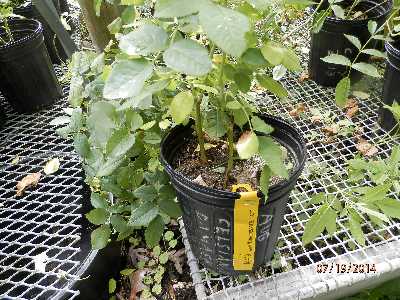

I take cuttings from a variety of plants all year and stick them in 1 gallon pots to sell mail-order. I take thousands of cuttings from lilacs, old garden roses, hybrid rugosa roses, rambler roses, blueberry bushes, native azaleas and rhododendrons (although I wont know if they have rooted until they come out of dormancy in spring having survived the winter). I usually wont sell the rooted cuttings until they are 2 years old or older and have flowered so I can be sure that the plant is well established. I take pictures whenever I interact with plants showing them in my newsletter and elsewhere in my web pages (each picture has the date the picture was taken in the lower right hand corner so click this image for a larger image and check the date).
cuttingsalexandermackenziesmall.jpg, cuttingscelsianadamasksmall.jpg
You give me a list of plants you want and sometimes some of them are varieties I have not propagated before but are hardy and disease resistant (if I can get a source of cuttings I may decide to propagate it every year). I only propagate plants that are hardy enough to be over-wintered locally out in the cold with their pots surrounded by mulch, and disease resistant enough so I dont have to use fungicide to keep the foliage looking good. I prefer to propagate plants by sticking four cuttings in a 1 gallon pot (the variety name and date stuck are printed on the side of the pot with a paint pen), inserting it in a 2 gallon ziplock bag and overwintering in the bag, but we also stool layer and divide, especially roses and lilacs. When I run out of time or energy to propagate plants I bag them up and send them priority mail to a greenhouse that I have contracted with to root them and return them the following June (I bag them altogether by type; alba, gallica, damask, centifolia, rugosa, rambler, etc. we will identify them when they flower). www.floweringshrubfarm.com/propagat.htm
coldframesmall.jpg, coldframeinwintersmall.jpg
In the fall roses are removed from their tables and inserted in coldboxes where they will be protected from dessication, mice and deer until the following spring. 2013 was a bad year for me because mice got into the cold box and there were not enough poison baits to deal with them (Lilacs, blueberry bushes and azaleas sold well but mail order roses are at least half of our sales). Everything survived by coming back from the roots but because plants got eaten back to soil level most plants did not flower and so they were not identified. Click the picture and it will open a larger image you can save as wallpaper. www.floweringshrubfarm.com/coldfram.htm
coldframetablesmall.jpg
After the winter is over and it warms up the cold box is used as a table. We may cover the hoops of the larger house in spring so when its 40 degrees outside it maybe 70 inside and a lot more comfortable for anyone potting plants, but uncovering the house in winter means I dont have to worry about snow collapsing it. In January and February I do paper work and edit my web pages. Most of our sales will occur in May, June, July and August but you should try to let me know what you want as early as possible in an email. As plants become available I'll email you back to see if you still want them, giving priority to those who emailed me first.
junestockplantssmall.jpg
When plants outgrow their one gallon pots they are repotted into gradually larger pots and either used to take cuttings from or sold to people who are willing to come to the nursery and pick them up. For more information check the links below.
januarycoldframesmall.jpg
Sources of cuttings below.
bigfantinlatoursmall.jpg,
This fantin Latour rose is in a 5 by 5 raised bed. The weeds are thinned out every spring while plants are still dormant we can ttake the raised bed apart, remove weeds and put the bed back together better than ever. We just remove heal cuttings leaving the basic structure in place without cutting it back.
bigispahansmall.jpg
This damask rose 'Ispahan' in a 45 gallon pot only has heal cuttings removed from it (the 45 gallon is 30 inches across rim to rim).
bignewdawnsmall.jpg
januarycoldboxopensmall.jpg
januarycoldboxopenedsmall.jpg,
I can open the coldbox to insert more poison baits.
januarypotsinfieldsmall.jpg
Andy
Contact me or check prices on my contact page at;
Go to my home page at;
Read about propagation at;
www.floweringshrubfarm.com/propagat.htm
My list allows me to figure out how many plants I should propagate and is at;
www.floweringshrubfarm.com/2014.htm
If I have 10 of a variety on the list I try to propagate 40 of that variety (and that does not include those we send out to greenhouse).
Copied from my home page;
I propagate and grow plants that are locally HARDY, DISEASE RESISTANT, VIGOROUS and FRAGRANT to sell during our Retail Plant Sale , Mail Order or by Appointment. We grow Classic Lilacs mostly those that have flowers that look purple or are double. Disease Resistant Roses including; All Roses arranged alphabetically, Roses hardy in Zone 3, Alba Roses, Gallica Roses, Damask Roses, Centifolia Roses, Hybrid Rugosa Roses, Climbing Roses & Rambler Roses, Roses with small flowers, Old Garden Roses mentioned in literature. Native Azaleas and Rhododendrons including Pinxterbloom azalea or R. nudiflorum / R. periclymenoides, and Rosebay rhododendron or R. maximum. We also grow many hardy Blueberry Bushes including native blueberry V. corrymbosum (Highbush Blueberry), V angustifolium (Lowbush Blueberry) and Half High Blueberry bushes that are a super hardy hybrid of highbush and lowbush. Espalier Trained fruit Trees including; Step over or Horizontal T trained Apple trees, Pear trees and Crabapple trees. I add new pictures to this months newsletter every week; January February March April May 1 to 15 May 16 to 31 June week #1 June week #2 June week #3 June last days July August September October November December Contact me!